
2 packages of oil based mud drilling cuttings treatment system have been ready for shipment. The order is from a reputable drilling company in their company. They are mainly focusing on deep drilling activities. They compared GN waste management equipment quality after comparing with U.S brand and some Chinese brands. Finally they believe GN Solids Control is the best choice.
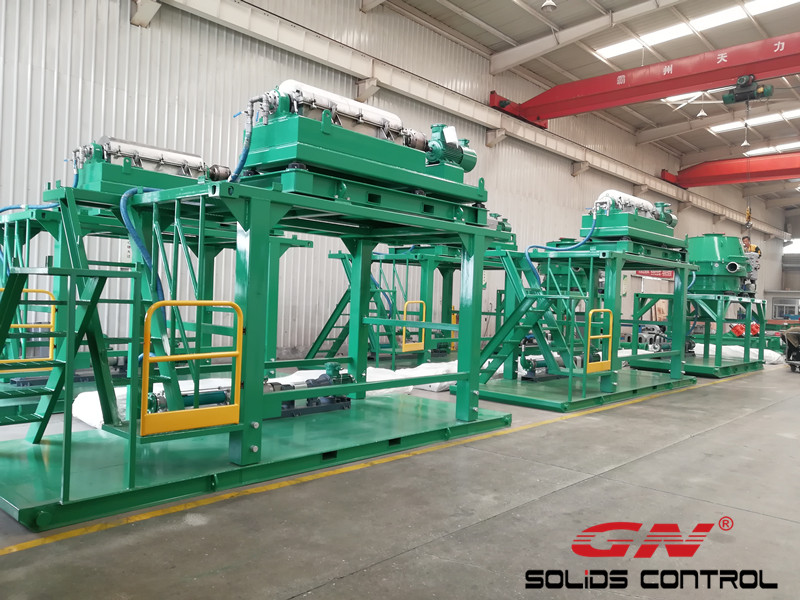
Each packages of the oil based mud drilling cuttings treatment system is including below items:
1) 2 sets High speed centrifuge for each package for barite recovery and fine solids separation. Thedecanter centrifugewill be put on telescopic skid, in this case, the recovered clean liquids can flow to outsides tank or clients’ storage tank directly. It saves cost for a separate transfer tank and transfer pump for the output liquids.
The feeding screw pumps and VFD control panels are both located in the same skid. All internal connections are included in the system. Clients only need to prepare a power cable for connecting to the power supplier.
2) 1 set of vertical cuttings dryer complete with lubrication system and flushing pump, all items and internal connections (cables, plugs, sockets, fittings) are offered by GN, all items are localted in the telescopic skid for easy movement.
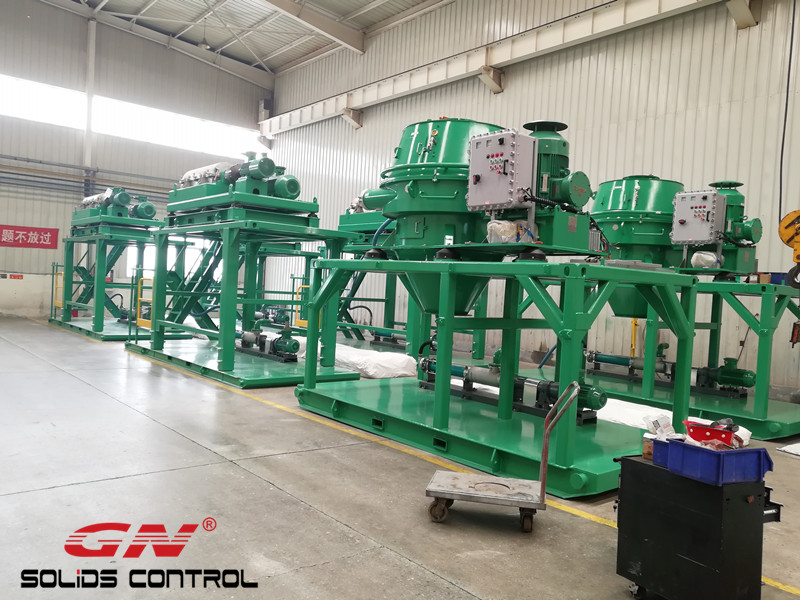
3) GN Solids Control offered different sizes screw conveyors to feeding and transfer cuttings between different units. All auger screw conveyors are variable speed control. Clients can adjust the rotating speed in order to get different transfer capacity for different materials and applications.
Why the client finally chose GN after comparing many different suppliers?
1) GN Solids Control is the only one Chinese supplier who does offer PLC smart control VFD control panel for oil field decanter centrifuges. GN Solids Control has CNEX and IECXE certificate for explosion proof control systems fabrication. They know more about their equipment so they know well to optimize the design. Even the U.S centrifuge suppliers are not capable for VFD control panel. They have to outsource.
2) GN Solids Control is the only one Chinese supplier who does offer A/C cooling systems for high temperature ambient areas.
- Details
-
Published: 22 April 2018
GN solids control is a leading manufacturer for mud solids control equipment, drilling waste management equipment and different models replacement shaker screens. GN Solids Control design and make different standard drilling cuttings treatment system per clients’ project request and their jobsite situation. GN Solids Control also has some standard drilling mud purification system and drilling cuttings treatment system which can suit for the general situation of most projects. In enable the clients can get the complete solution for a reliable mud system within short delivery time and with very good price.
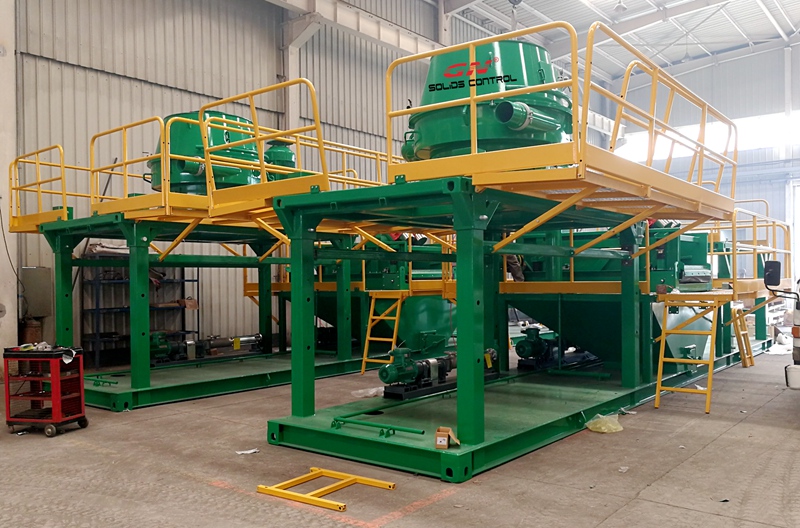
GNCM-40A is one a standard cuttings drying system from GN Solids Control. The cuttings drying system can be used to drilling the oil base mud and cuttings, as well as some kinds of water based mud and water based mud cuttings. The standard Cutting Management System is including below equipment:
1) 1 set of Vertical Cuttings Dryer GNCD930D, complete with a German brand progressive screw pump to flushing the screen baskets.
2) 1 set of 2-phase Decanter Centrifuge GNLW363C-VFD international Standard premium quality. The centrifuge is equipped with 3 VFD drives for 3 VFD control: for the main drive VFD control, the back drive VFD control and the feeding screw pump VFD control. The centrifuge feeding screw pump is with max. 30 m3/h capacity.
3) 2 sets Telescopic Skid for decanter centrifuge and vertical cuttings dryer respectively.
4) 1 set of Electric Cradle to the VG dryer screen changing and the normal maintenance.
5) Explosion proof Electrical Control system to control all above
3) A skid with catching tank to hold all above for fast movement.
Features of the GNCM-40A drill cuttings drying system:
The centrifuge on GNCM-40A is set up on a telescopic skid with height adjustable. The advantage of this design is to allow the fluids discharged from the centrifuge to flow to the storage tank or active mud tank by gravity. But when move the complete system by truck, the telescopic skid should be lower down, and there is no storage capacity for the catching fluids from centrifuge.
- Details
-
Published: 14 April 2018
In Beijing oil show, GN Solids Control exhibited his different sizes vacuum slurry pump units. GN Solids Control has a skid type vacuum transfer pump unit. GN Solids Control also owns 2 smaller size portable vacuum pumps in his equipment range. The portable vacuum slurry pumps are equipped with ties for easy movement.
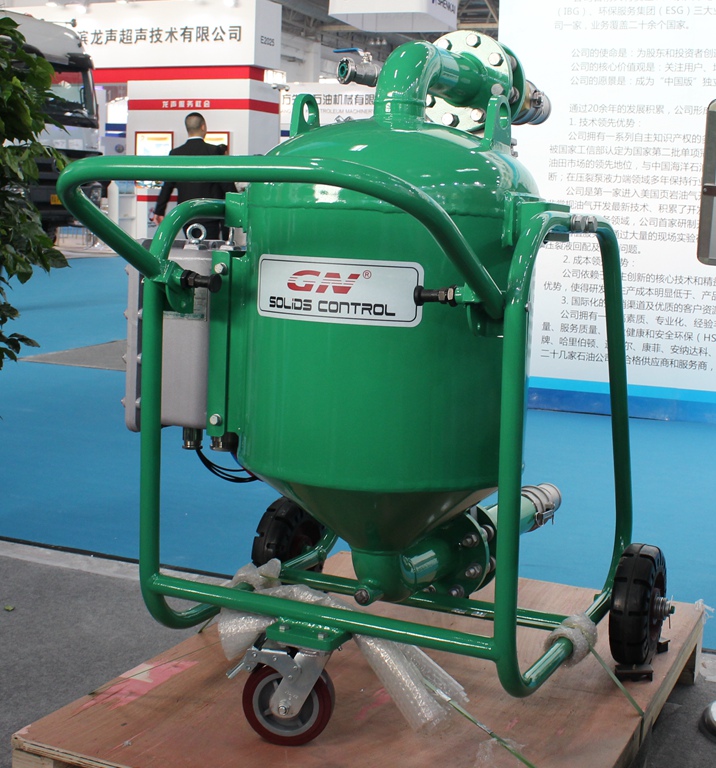
GN Solids Control makes the mobile type vacuum slurry pumps fitted with bigger wheels for easier maneuvering and ground clearance when moving around locations. On uneven surfaces and soft or sticky ground etc the little wheels would be a real hindrance. And it is good that GN Solids Control stayed away from Pneumatic Tires, and go with solid rubber as the air filled versions tend to make the Unit move around too much when it’s operating.
GN Solids Control will also show its different models of vacuum slurry pump units on OTC oil show in Houston in April 29 ~ 3 May, 2018. GN Solids Control has a company and a warehouse in Houston. And they will have 2 booths on the Houston oil show. Below is the information can help you find GN Solids Control on the OTC oil show in Houston:
Show Time & Location: 30 April - 3 May, 2018. NRG Park, Houston, Texas, USA
Booth No. 1: NRG Center 1369-1 (GN China)
Booth No. 2: NRG Arena 8000 (GN America)
For clients who are looking for some good pump for pumping out oil sludge from Oil tanks on ships, the vacuum slurry pump units must be a perfect choice.
The vacuum slurry pump units can suck and discharge oil sludge or waste oil remains which are very viscous and have some loose particles. The max. suction depth of the vacuum slurry pump units is up to 50m. So even the depth of tank is around 30m or 35m, it is no problem. And the max. transfer distance of the vacuum slurry pump units can reach up to 1000m. But the the different discharging head and the material situation, the exact transfer length should vary.
Besides vacuum slurry pump units, GN Solids Control also have other type of transfer pump, like screw pump, centrifugal pump, shearing pump, etc… For clients who are looking for pumps to pump the viscous oil sludge, they can contact GN sales team for help.
- Details
-
Published: 07 April 2018
The 2018 Beijing oil show was gone with great success for GN Solids Control company. The same as all previous years, GN Solids Control took its new technology and equipment for the show to communication with clients and peers.
This year, GN Solids Control new products are all focusing on oily sludge treatment, which is a new trench for waste management. As more and more people realize the importance of importance of environment protection, and the government increases the standard of environment protection, industry waste control and treatment becomes a new trends. More and more services companies are looking for new technologies and efficiency way for waste management control, especially the oily sludge waste and the contaminated soils.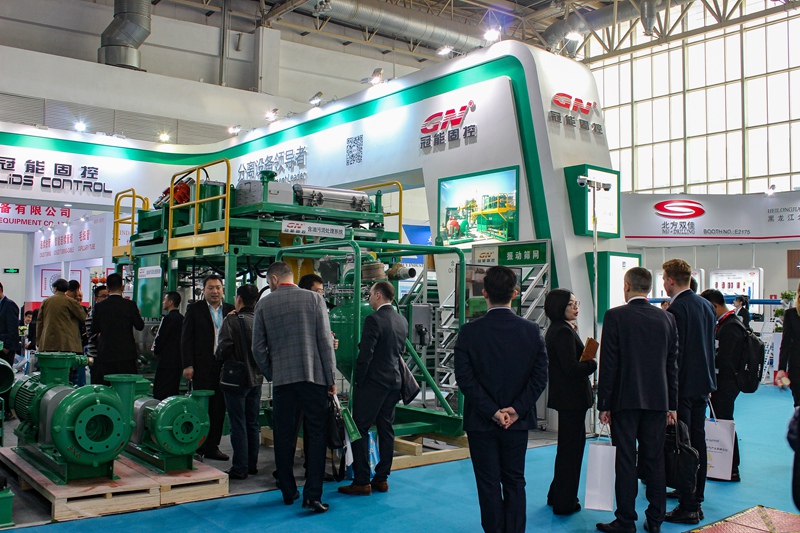
GN made Oily sludge treatment system get much focuses on the oil show as its compact design and full functional.
The system includes below processing equipment:
1) A pre-mixing and heating tank. Operators feed the oil sludge to the premixing tank, they can dilution and heating the materials per needed in the tank.
2) There is a 4-tank chemical dosing unit is equipped in the system. There are 3 tanks for automatically PAM mixing and dosing. Operators can dose chemicals to premixing tank for demulsification, to make the oily sludge easier for next process. The 4th tank in the chemical dosing unit is for PAC liquid chemical dosing for flocculation.
3) After mixing in the premixing tank, material will be fed to a shale shaker to remove the big size solids. Then the solids will be discharged outside of the system, the liquid will be recovered to a small storage tank and then feed to decanter centrifuge. Before liquid entering into decanter centrifuge, flocculants will be added to remove as more ultrafine solids as possible.
4) A 3-phase centrifuge is followed by the decanter centrifuge to separate oil and water. And then the oil and water will flow to the oil tank and water tank respectively.
Above is just a direct introduction of the oily sludge treatment system. For clients who want for more detailed information, please contact GN Solids Control sales managers.
- Details
-
Published: 31 March 2018
GN Solids Control makes different sizes of centrifugal pump to suits to different applications, like for mud mixing by working together with mixing hopper, to feeding for desander and desilter mud cleaner, to feed for decanter centrifuge, to be used as trip pump, charging pump, to work as transfer pump to here to there, and work as suction tank to suck drilling fluids from mud system and feed for mud pump for drilling activities.

Here are major centrifugal pump sizes made and sold by GN Solids Control: GNSB4×3, GNSB5×4, GNSB6×5, GNSB8×6. The 2 numbers here indicate the pump inlet and outlet sizes in inch, the bigger number standards for the suction pipe size, while the smaller number indicates the outlet pipe size. For centrifugal pump, the inlet size must be bigger than outlet pipe. Another important design to determine the pump performance is the diameter of the pump impellers. For the same pump size, the bigger size the pump impeller, the bigger flow it can handle. And the motor power must be accordance with the pump size (inlet size, output size and the impeller size).
GN Solids Controlpump design and all its spare parts are fully interchangeable with a traditional famous pump model: Mission Magnum. In this case, clients can easy source spare parts and replace GN pumps in their existing systems.
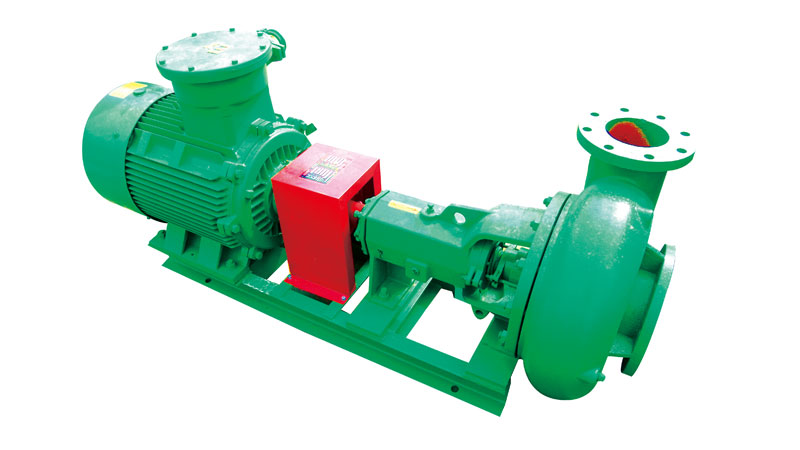
There are so many pump manufacturer, while GN Solids Pump performance better than others’? Below are some advantages of GN Solids Control centrifugal pump:
1) Thick, Strong Concentric casing provides extended life over conventional volute designs. The Concentric design minimizes turbulence and abrasive wear.
2) GN Solids Control pump casings are all made from hard ductile iron alloy, increased abrasion resistant capability compared to competitors’ pumps.
3) Wide open-vane impeller creates lower axial thrust for improved bearing life.
4) Anti-loosening impeller lock bolt to eliminate pump damage in case of improper motor hook-up.
5) The skid for supporting pump and motor is made from casting instead of welding to provide reliable operation and less vibration in a result to extend the pump and motor life.
GN Solids Control owns the full production line for big sizes decanter centrifuge manufacturing. GN Solids Control utilize the same production line as centrifuge to make centrifugal pump, which ensure a reliable and excellent performance.
- Details
-
Published: 24 March 2018
As one of the major liquid and solids separation centrifuge manufacturer, GN Solids Control exported many dewatering centrifuge systems to worldwide market, like Canada, British, Singapore, UAE… GN dewatering centrifuge system can be used in oil field and non-oil field.
GN Solids Control exported many big bowl dewatering centrifuge systems to Singapore for construction field waste water treatment. It can be used to treat and recycle waste water from horizontal directional drilling, from piling project, from micro tunneling projects, from dredge slurry separation projects, or from other pipeline and underground activities.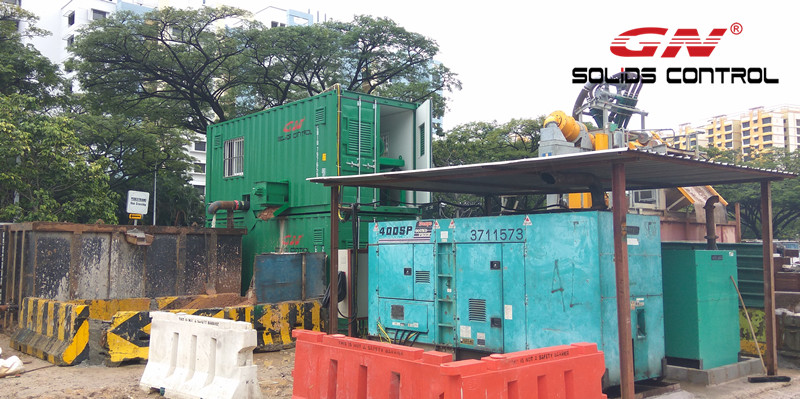
Recently, GN engineer come back from Singapore and finished the commissioning and training works of a new dewatering centrifuge system there. Now the waste water treatment system is running well, clients are happy with it.
The water centrifuge for Singapore client is very similar to other dewatering centrifuges sold there before. It includes below processing equipment:
1) Big bowl decanter centrifuge GNLW553C-VFD. It is a 22inch big bowl decanter centrifuges widely used for fine solids separation, for drilling mud separation and waste water treatment.
2) An automatically power chemical mixing and dosing system. The chemical dosing system will be used before the waste water feeds to the centrifuge bowl for flocculation.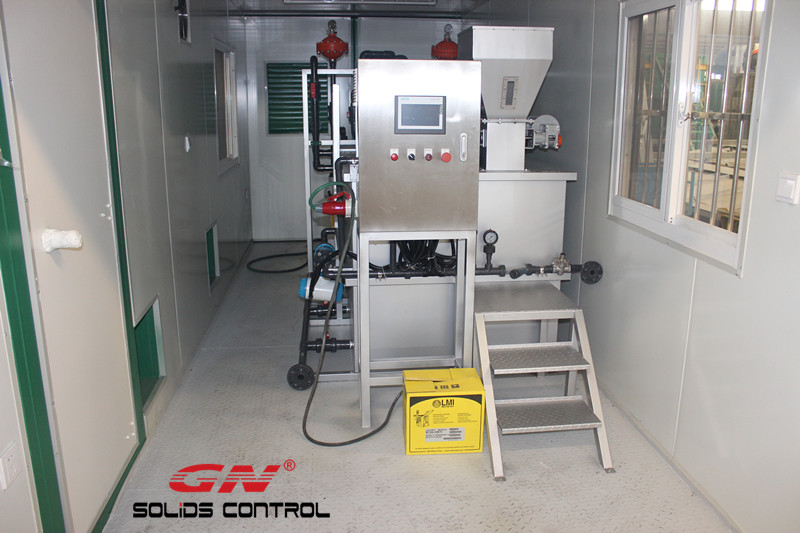
3) As the construction waste water treatment is mostly took at near the city or in the city. There I a strict limitation on space. GN Solids Control fixed Both the automatically power chemical mixing and dosing system and the 22 inch big bowl centrifuge into containers respectively. And the 2 containers can be laid at 2 layers. The big bowl decanter centrifuge container will be put on top of the chemical dosing system container. It is easy for movement and can saves space.
The centrifuge dewatering system is used after the slurry separation system. The slurry separation system will remove most of the big size solids in liquid, to reduce the mud weight and the solids contents, and to make the waste water qualified for centrifuge separation. GN Solids Control can also offer the slurry separation system (C/W with shale shaker, hydro cyclone separator, feeding pumps, mud tank system, lighting system, electrical control system).
- Details
-
Published: 17 March 2018